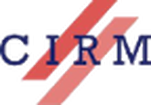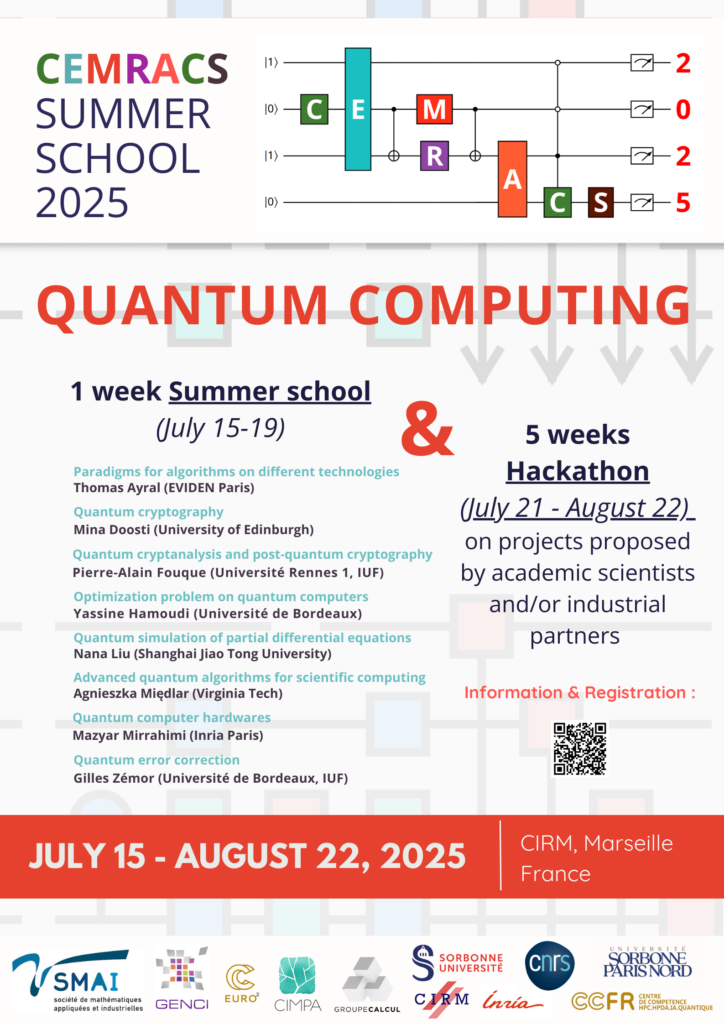Scientific Committee
Comité scientifique
Éric Cancès (École des Ponts ParisTech)
Shi Jin (Shanghai Jiao Tong Univ.)
Elham Kashefi (Univ. Edinburgh and CNRS)
Tanja Lange (Technische Universiteit Eindhoven)
Lin Lin (UC Berkeley)
Yvon Maday (Sorbonne Université)
Sauro Succi (Italian Institute of Technology at La Sapienza, Roma)
Organizing Committee
Comité d’organisation
Karim Azoum (Centre de compétence CC-FR, Teratec)
Igor Chollet (LAGA, Sorbonne Université Paris Nord)
Guillaume Delay (LJLL, Sorbonne Université & Inria)
Mi-Song Dupuy (LJLL, Sorbonne Université)
Benoit Fabrèges (Institut Camille Jordan, Université Claude Bernard Lyon 1)
Cindy Guichard (LJLL, Sorbonne Université & Inria)
Marie Lhande Pincemin (Centre de compétence CC-FR, Teratec)
Ludovic Perret (LIP6, Sorbonne Université)
Marie Postel (LJLL, Sorbonne Université)
Olivier Ruatta (XLIM, Université Limoges)
Pascal Tremblin (CEA & Maison de la Simulation)
contact: cemracs25@smai.emath.fr
Program
The principle of this event, organised by SMAI (Société de Mathématiques Appliquées et Industrielles) relies on strong industrial partnerships and has a two-period structure: the first phase consists of one week of lectures (July 15 to 19), and the second of a five-week period of project-based research. During the second phase, each participant works in a team on a collaborative research project proposed either by an industrial company or an academic team. Teams are made up of 2 or 3 young researchers, supervised by one or two experienced researchers provided by the company or academic team which proposed the project. The program includes:
- 1 week summer school (July 15-19)
- 5 weeks Hackathon / Projects on projects proposed by academic scientists and/or industrial partners (July 21 – August 22)
About Quantum Computing
CEMRACS 2025 is dedicated to quantum computing, focusing on training students in the ideal quantum computer framework and its associated algorithms, such as those for number search, prime factorization, phase estimation, and solving linear systems. The proposal also plans to address the limitations of quantum computing, including error management. Two main application areas with common algorithmic tools are highlighted:
- Explore the potential of quantum computing in scientific computations, including the adaptation and performance gains of existing algorithms in a quantum framework. This application is part of the France Hybrid HPC Quantum Initiative (HQI)
- Quantum cryptography: given the effectiveness of quantum algorithms in cryptography, this area focuses on the need to develop new encryption methods for the post-quantum era. The active community in this field will contribute to CEMRACS
Summer school
This summer school focused on the bascis of quantum computer applied to various fields in sientific computation and cryptography. it aims to provide a basis knowledge for the participants that will remain on the next 5 weeks working on dedicated projects. The typical work day will consist in four one-hour-and-a-half sessions, starting at 9am, 10:45am, 2pm and 4pm. The last session may last for two hours if necessary. Each slot will be dedicated either to a classical lecture, a shorter presentation or to a computational practice session.
Lectures
Abstract:
In these two lectures, I will introduce the main algorithms used in today’s noisy and tomorrow’s fault-tolerant quantum computers. After a quick introduction to gate-based quantum computation, I will review basic primitives like the quantum Fourier transform and their use in algorithms such as quantum phase estimation, with applications to the factoring problem (Shor’s algorithm) and energy estimation in quantum physics. Then, I will turn to the challenges of decoherence in quantum computers, to the variational algorithms that have been designed to mitigate its effects (including the variational quantum eigensolver, VQE), and to their limitations and some counter-measures like error mitigation. In the hands-on session, we will implement a phase estimation algorithm as well as a VQE algorithm applied to a quantum chemistry problem.
Abstract:
Quantum information offers fundamentally new ways to achieve cryptographic tasks, sometimes beyond the capabilities of classical cryptography. In these two lectures, I will first introduce the important concepts in Quantum Information, and we will try to understand together how quantum communication enables new possibilities for cryptographic protocols. We will then explore quantum key distribution (QKD), the most well-known quantum cryptography protocol, understanding how it works and its security guarantees. I will also go beyond QKD to briefly discuss other cryptographic primitives where quantum cryptography has fundamental advantages and limitations, such as commitment or coin flipping. Finally, I will discuss emerging research directions in quantum communication that push the boundaries of secure information processing.
Abstract:
In this course, I will present basic quantum algorithms and describe in detail polynomial-time factorization algorithms, and in particular the Quantum Fourier Transform. I will also show more recent improvements due to Regev, Ragavan and Vaikuntanathan, and Chevignard, Fouque, and Schrottenloher.
In the lab course, you will simulate quantum algorithm using the Qiskit SDK in Python.
Abstract:
The potential of quantum algorithms for solving optimization problems has been explored since the early days of quantum computing. This course introduces some of the key ideas and algorithms developed in this context, along with their fundamental limitations. Depending on the available time, topics covered may include: quantum optimization algorithms inspired by physics (adiabatic algorithms, variational algorithms, QAOA, quantum annealing, etc.), quantum algorithms for convex optimization (acceleration of first- and second-order methods, oracular problems, etc.), applications to combinatorial optimization (graph problems, quadratic binary optimization, etc.).
Abstract:
One of the oldest and currently most promising application areas for quantum devices is quantum simulation. Popularised by Feynman in the early 1980s, it is important for the efficient simulation – compared to its classical counterpart – of one special partial differential equation (PDE): Schrodinger’s equation. This is possible because quantum devices themselves naturally obey Schrodinger’s equation. Just like with large-scale quantum systems, classical methods for other high-dimensional and large-scale PDEs often suffer from the curse-of-dimensionality, which a quantum treatment might in certain cases be able to mitigate. Aside from Schrodinger’s equation, can quantum simulators also efficiently simulate other PDEs? To enable the simulation of PDEs on quantum devices that obey Schrodinger’s equations, it is crucial to first develop good methods for mapping other PDEs onto Schrodinger’s equations.
After a brief introduction to quantum simulation, I will address the above question by introducing a simple and natural method for mapping other linear PDEs onto Schrodinger’s equations. It turns out that by transforming a linear partial differential equation (PDE) into a higher-dimensional space, it can be transformed into a system of Schrodinger’s equations, which is the natural dynamics of quantum devices. This new method – called /Schrodingerisation/ – thus allows one to simulate, in a simple way, any general linear partial differential equation and system of linear ordinary differential equations via quantum simulation.
This simple methodology is also very versatile. It can be used directly either on discrete-variable quantum systems (qubits) or on analog/continuous quantum degrees of freedom (qumodes). The continuous representation in the latter case can be more natural for PDEs since, unlike most computational methods, one does not need to discretise the PDE first. In this way, we can directly map D-dimensional linear PDEs onto a (D + 1)-qumode quantum system where analog Hamiltonian simulation on (D + 1) qumodes can be used. It is the quantum version of analog computing and is more amenable to near-term realisation.
These lectures will show how this Schrodingerisation method can be applied to linear PDEs, systems of linear ODEs and also linear PDEs with random coefficients, where the latter is important in the area of uncertainty quantification. Furthermore, these methods can be extended to solve problems in linear algebra by transforming iterative methods in linear algebra into the evolution of linear ODEs. It can also be applicable to certain nonlinear PDEs. We will also discuss many open questions and new research directions.
Abstract:
Quantum computing promises to transform computational capabilities across diverse fields. The rapid advancement of quantum algorithms has expanded the potential of quantum computing for tackling a broad spectrum of scientific computing challenges. In this lecture, we will present fundamental concepts of quantum algorithms, focusing on solving large-scale numerical linear algebra problems as well as addressing high-dimensional linear and nonlinear differential equations. We will start with basic notions of quantum states, unitary operators, no-cloning theorem and measurements. After introducing block-encoding and linear combination of unitaries (LCU), we will discuss various quantum algorithms for scientific computing, i.e., Quantum Linear System Problem (QLSP), Quantum Singular Value (Eigenvalue) Transformation (QSVT), Hamiltonian Simulation and Trotterization, Adiabatic Quantum Computation (AQC), Variational Quantum Eigensolver (VQE), Quantum Krylov Algorithms and Quantum (linear) Differential Equation Solvers.
Abstract:
The remarkable progress in control and readout of atomic and solid-state qubits has led to an accelerated race towards building a useful quantum computer. A portion of the recent developments deal with noisy quantum bits and aim at proving an advantage with respect to classical processors. However, in order to fully exploit the power of quantum physics in computation, developing fault-tolerant processors is unavoidable. In such a processor, quantum bits and logical gates are dynamically and continuously protected against noise by means of quantum error correction. While a theory of quantum error correction has existed and developed since mid 1990s, the first experiments are being currently investigated in the physics labs around the world. I will review the main approach pursued in this direction and state of progress towards error corrected qubits. I will also present some shortcut approaches that are pursued to reduce the significant hardware overhead of error correction.
Schedule
| Tuesday 15/07 | Wednesday 16/07 | Thursday 17/07 | Friday 18/07 | Saturday 19/07 | |
|---|---|---|---|---|---|
| 08h45 | Welcome | ||||
| 09:00 | Mazyar Mirrahimi | Thomas Ayral Lecture 2 | Agnieszka Międlar Lecture 2 | Pierre-Alain Fouque Lecture 1 | Agnieszka Międlar Computer session |
| 10:30 | Coffee break | Coffee break | Coffee break | Coffee break | Coffee break |
| 10:50 | Thomas Ayral Lecture 1 | Gilles Zémor Lecture 1 | Mina Doosti Lecture 1 | Gilles Zémor Lecture 2 | Nana Liu Exexrcice session Pierre-Alain Fouque Computer session |
| 12:30 – 14:00 | Lunch | Lunch | Lunch | Lunch | Lunch |
| 14:00 | Yassine Hamoudi | Yassine Hamoudi | Nana Liu Lecture 1 | Mina Doosti Lecture 2 | |
| 15:30 | Coffee break | Coffee break | Coffee break | Coffee break | |
| 15:50 | Agnieszka Międlar Lecture 1 | Thomas Ayral computer session | Yassine Hamoudi Computer session | Nana Liu Lecture 2 Pierre-Alain Fouque Lecture 2 |
|
| 17:30 | Tutorial computer session (1h30) | Discussions (2h00) | |||
| 18:00 | Discussions | Discussions | |||
| 19:30 – 20:30 | Diner | Diner | Diner | Diner |



